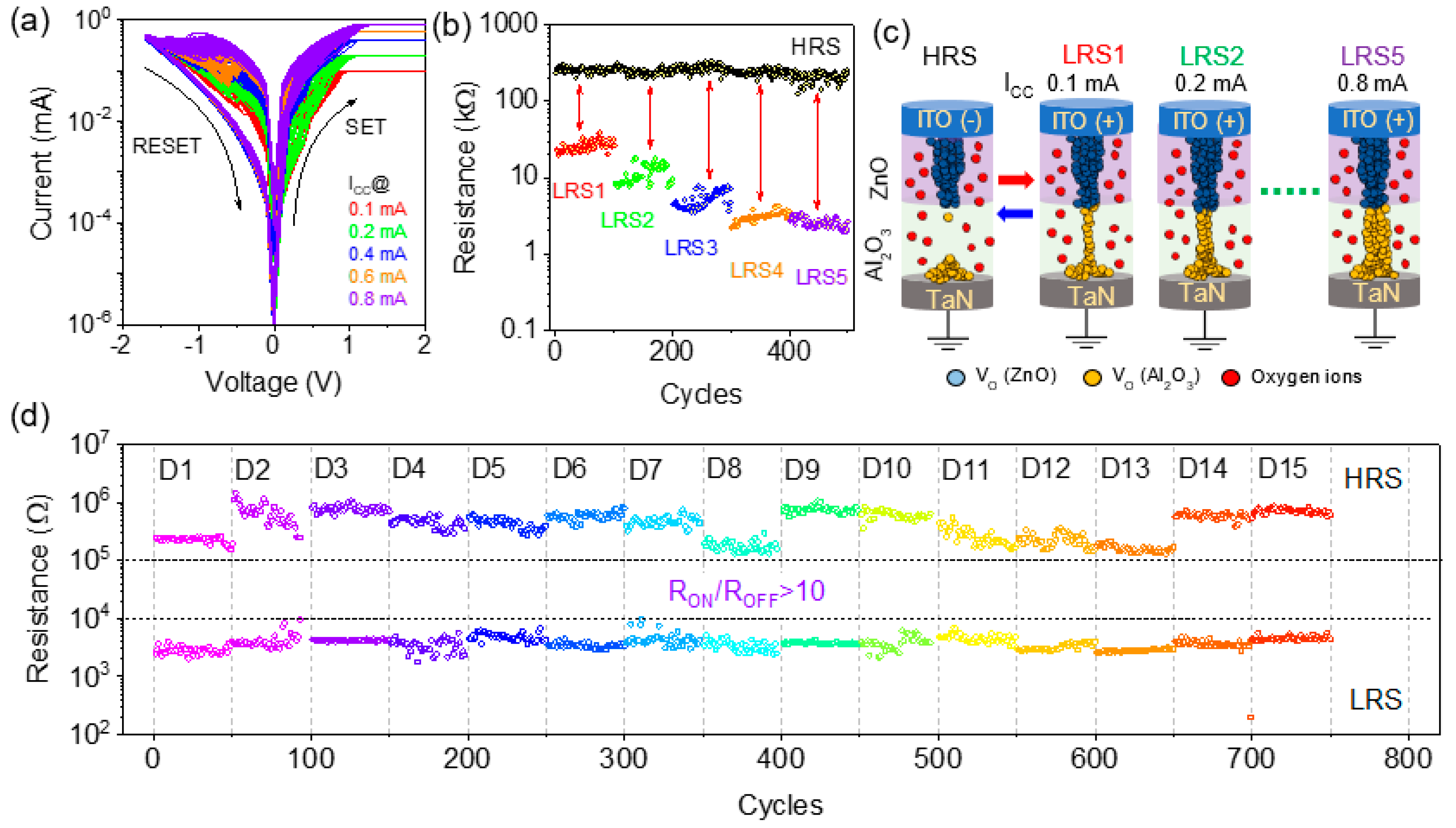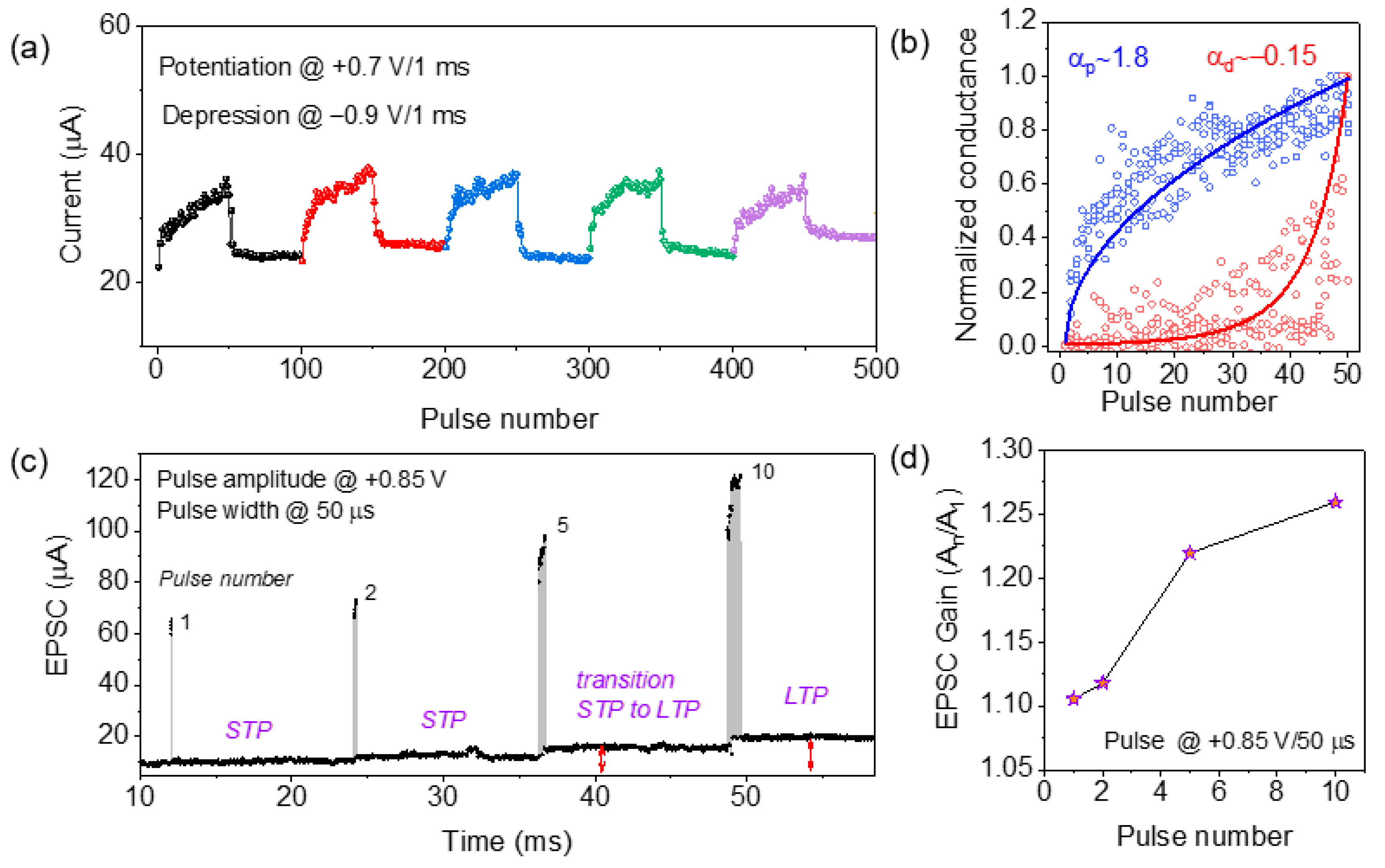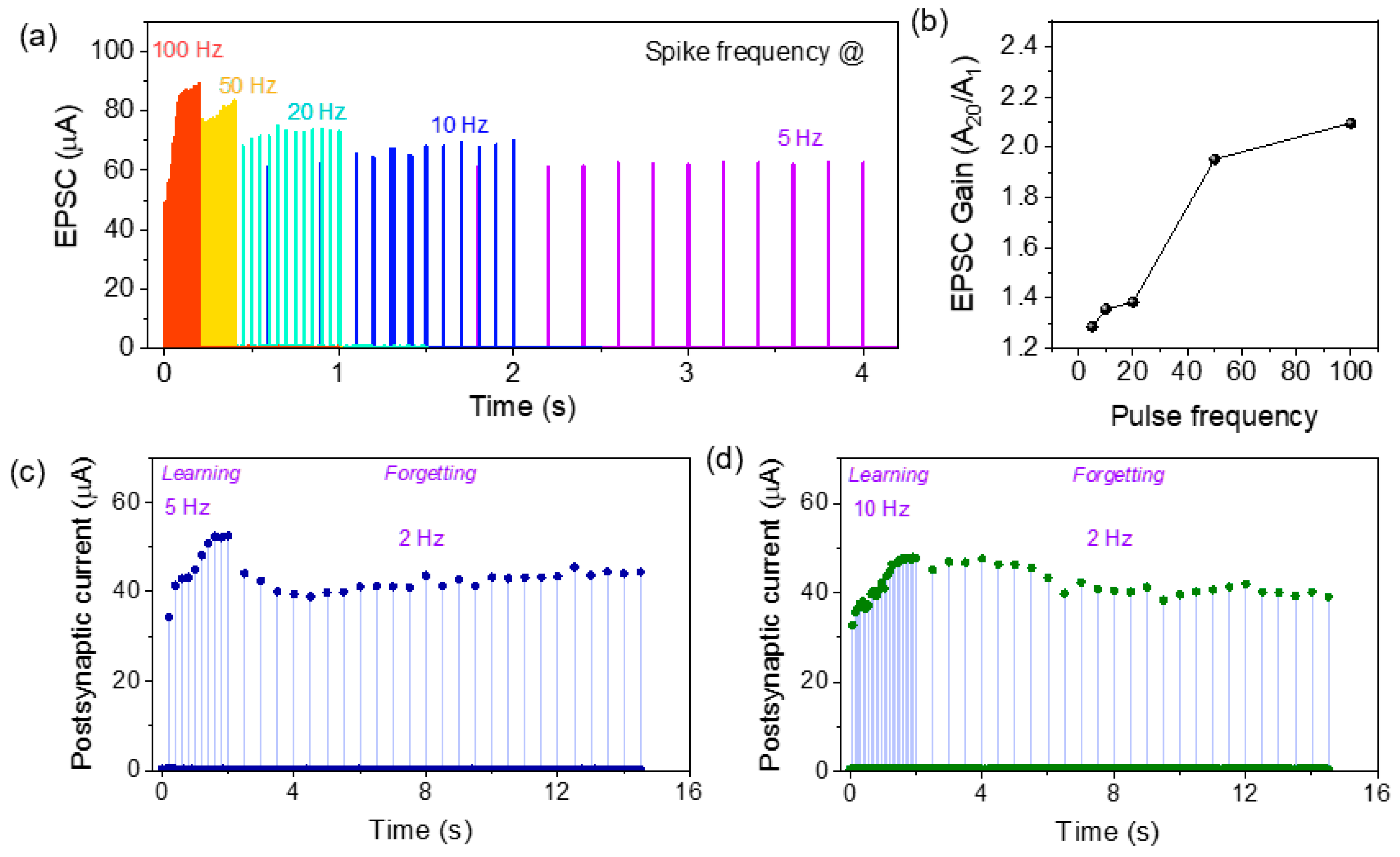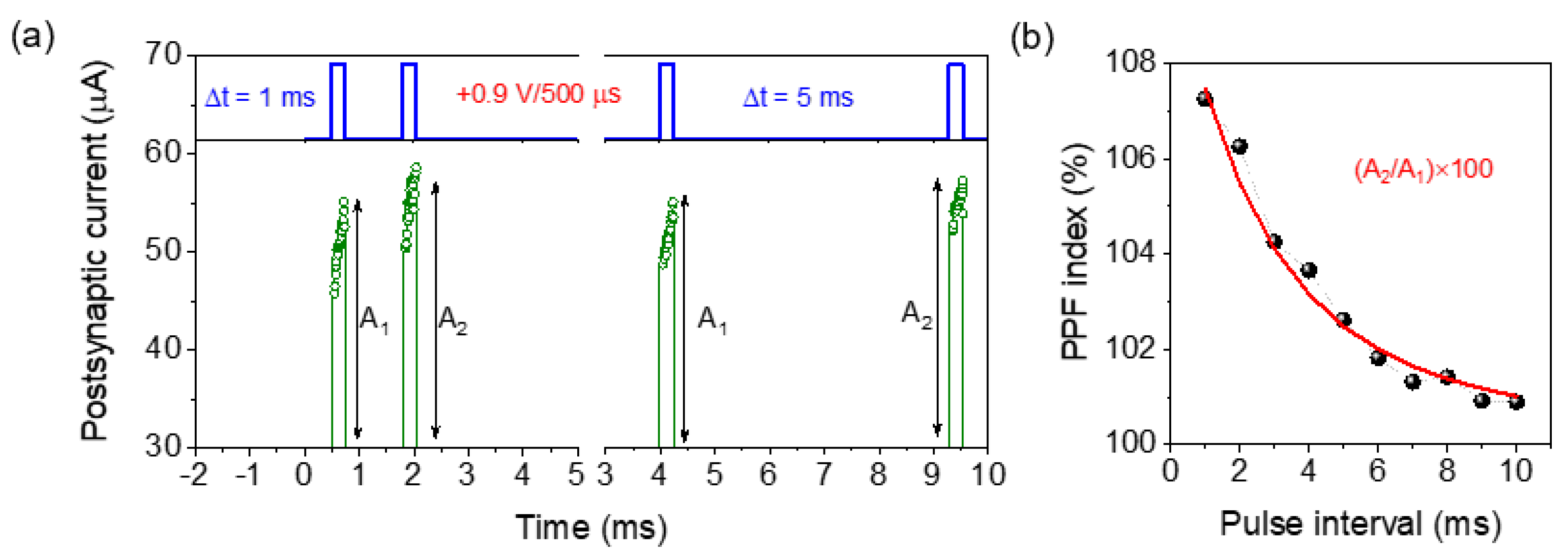Improved Resistive Switching with Low-Power Synaptic Behaviors of ZnO/Al2O3 Bilayer Structure
Abstract
:1. Introduction
2. Materials and Methods
3. Results and Discussion
3.1. Structural Characterization
3.2. Electroforming and Bipolar Resistive Switching of ITO/ZnO/Al2O3/TaN Device
3.3. Synaptic Characteristics under Identical Pulse Sequence
3.4. Pulse-Frequency-Dependent and Experience-Dependent Synaptic Properties
3.5. Paired-Pulse Facilitation(PPF) Emulation
4. Conclusions
Supplementary Materials
Author Contributions
Funding
Institutional Review Board Statement
Informed Consent Statement
Data Availability Statement
Conflicts of Interest
References
- Kim, M.K.; Lee, J.S. Short-Term Plasticity and Long-Term Potentiation in Artificial Biosynapses with Diffusive Dynamics. ACS Nano 2018, 12, 1680–1687. [Google Scholar] [CrossRef]
- Ambrosi, E.; Bricalli, A.; Laudato, M.; Ielmini, D. Impact of oxide and electrode materials on the switching characteristics of oxide ReRAM devices. Faraday Discuss. 2019, 213, 87–98. [Google Scholar] [CrossRef] [PubMed]
- Ielmini, D. Resistive switching memories based on metal oxides: Mechanisms, reliability and scaling. Semicond. Sci. Technol. 2016, 31, 063002. [Google Scholar] [CrossRef]
- Sun, B.; Guo, T.; Zhou, G.; Ranjan, S.; Jiao, Y.; Wei, L.; Zhou, Y.N.; Wu, Y.A. Synaptic devices based neuromorphic computing applications in artificial intelligence. Mater. Today Phys. 2021, 18, 100393. [Google Scholar] [CrossRef]
- Yu, S.; Gao, B.; Fang, Z.; Yu, H.; Kang, J.; Wong, H.S.P. A low energy oxide-based electronic synaptic device for neuromorphic visual systems with tolerance to device variation. Adv. Mater. 2013, 25, 1774–1779. [Google Scholar] [CrossRef]
- Moon, K.; Lim, S.; Park, J.; Sung, C.; Oh, S.; Woo, J.; Lee, J.; Hwang, H. RRAM-based synapse devices for neuromorphic systems. Faraday Discuss. 2019, 213, 421–451. [Google Scholar] [CrossRef]
- Camacho-Berríos, A.A.; Pantojas, V.M.; Otaño, W. Reactive sputtered ZnO thin films: Influence of the O2/Ar flow ratio on the oxygen vacancies and paramagnetic active sites. Thin Solid Film. 2019, 692, 063002. [Google Scholar] [CrossRef]
- Zhao, J.; Dong, J.Y.; Zhao, X.; Chen, W. Role of oxygen vacancy arrangement on the formation of a conductive filament in a Zno thin film. Chin. Phys. Lett. 2014, 31, 3–6. [Google Scholar] [CrossRef]
- Gu, T. Metallic filament formation by aligned oxygen vacancies in ZnO-based resistive switches. J. Appl. Phys. 2014, 115, 203707. [Google Scholar] [CrossRef]
- Gul, F.; Efeoglu, H. ZnO and ZnO1−x based thin film memristors: The effects of oxygen deficiency and thickness in resistive switching behavior. Ceram. Int. 2017, 43, 10770–10775. [Google Scholar] [CrossRef] [Green Version]
- Lin, C.C.; Tang, J.F.; Su, H.H.; Hong, C.S.; Huang, C.Y.; Chu, S.Y. Multi-step resistive switching behavior of Li-doped ZnO resistance random access memory device controlled by compliance current. J. Appl. Phys. 2016, 119, 244506. [Google Scholar] [CrossRef]
- Xiao, J.; Herng, T.S.; Ding, J.; Zeng, K. Resistive switching behavior in copper doped zinc oxide (ZnO:Cu) thin films studied by using scanning probe microscopy techniques. J. Alloys Compd. 2017, 709, 535–541. [Google Scholar] [CrossRef]
- Simanjuntak, F.M.; Prasad, O.K.; Panda, D.; Lin, C.A.; Tsai, T.L.; Wei, K.H.; Tseng, T.Y. Impacts of Co doping on ZnO transparent switching memory device characteristics. Appl. Phys. Lett. 2016, 108, 3515–3520. [Google Scholar] [CrossRef]
- Wang, L.G.; Qian, X.; Cao, Y.Q.; Cao, Z.Y.; Fang, G.Y.; Li, A.D.; Wu, D. Excellent resistive switching properties of atomic layer-deposited Al2O3/HfO2/Al2O3 trilayer structures for non-volatile memory applications. Nanoscale Res. Lett. 2015, 10, 135. [Google Scholar] [CrossRef] [PubMed]
- Banerjee, W.; Xu, X.; Lv, H.; Liu, Q.; Long, S.; Liu, M. Variability improvement of TiOx/Al2O3 bilayer nonvolatile resistive switching devices by interfacial band engineering with an ultrathin Al2O3 dielectric material. ACS Omega 2017, 2, 6888–6895. [Google Scholar] [CrossRef] [PubMed]
- Mahata, C.; Lee, C.; An, Y.; Kim, M.H.; Bang, S.; Kim, C.S.; Ryu, J.H.; Kim, S.; Kim, H.; Park, B.G. Resistive switching and synaptic behaviors of an HfO2/Al2O3 stack on ITO for neuromorphic systems. J. Alloys Compd. 2020, 826, 154434. [Google Scholar] [CrossRef]
- Chen, L.; Xu, Y.; Sun, Q.-Q.; Liu, H.; Gu, J.-J.; Ding, S.-J.; Zhang, D.W. Highly Uniform Bipolar Resistive Switching With Al2O3 Buffer Layer in Robust NbAlO-Based RRAM. IEEE Electron Device Lett. 2010, 31, 356–358. [Google Scholar] [CrossRef]
- Song, W.; Wang, W.; Lee, H.K.; Li, M.; Zhuo, V.Y.-Q.; Chen, Z.; Chui, K.J.; Liu, J.-C.; Wang, I.-T.; Zhu, Y.; et al. Analog switching characteristics in TiW/Al2O3/Ta2O5/Ta RRAM devices. Appl. Phys. Lett. 2019, 115, 133501. [Google Scholar] [CrossRef]
- Qiao, Q.; Xu, D.; Li, Y.W.; Zhang, J.Z.; Hu, Z.G.; Chu, J.H. Detection of resistive switching behavior based on the Al2O3/ZnO/Al2O3 structure with alumina buffers. Thin Solid Film. 2017, 623, 8–13. [Google Scholar] [CrossRef]
- Park, J.; Huh, D.; Son, S.; Kim, W.; Ju, S.; Lee, H. Transparent, Flexible, and Low-Operating-Voltage Resistive Switching Memory Based on Al2O3/IZO Multilayer. Glob. Chall. 2022, 6, 2100118. [Google Scholar] [CrossRef]
- Kumar, D.; Chand, U.; Wen Siang, L.; Tseng, T.-Y. High-Performance TiN/Al2O3/ZnO/Al2O3/TiN Flexible RRAM Device With High Bending Condition. IEEE Trans. Electron Devices 2020, 67, 493–498. [Google Scholar] [CrossRef]
- Wang, D.T.; Dai, Y.W.; Xu, J.; Chen, L.; Sun, Q.Q.; Zhou, P.; Wang, P.F.; Ding, S.J.; Zhang, D.W. Resistive Switching and Synaptic Behaviors of TaN/Al2O3/ZnO/ITO Flexible Devices with Embedded Ag Nanoparticles. IEEE Electron Device Lett. 2016, 37, 878–881. [Google Scholar] [CrossRef]
- Arya Lekshmi, J.; Nandha Kumar, T.; Jinesh, K.B. The effect of the top electrode on the switching behavior of bipolar Al2O3/ZnO RRAM. Microelectron. Eng. 2021, 250, 111637. [Google Scholar] [CrossRef]
- Gonzalez, M.B.; Rafí, J.M.; Beldarrain, O.; Zabala, M.; Campabadal, F. Charge trapping and electrical degradation in atomic layer deposited Al2O3 films. Microelectron. Eng. 2013, 109, 57–59. [Google Scholar] [CrossRef]
- Zhuge, F.; Peng, S.; He, C.; Zhu, X.; Chen, X.; Liu, Y.; Li, R.W. Improvement of resistive switching in Cu/ZnO/Pt sandwiches by weakening the randomicity of the formation/rupture of Cu filaments. Nanotechnology 2011, 22, 275204. [Google Scholar] [CrossRef]
- Dai, Y.; Zhong, Z.; Gong, S. Effect of ZnO grain boundaries on non-linearity: First-principles calculations. Mater. Res. Express 2018, 5, 065904. [Google Scholar] [CrossRef]
- Zhao, J.; Zhou, Z.; Zhang, Y.; Wang, J.; Zhang, L.; Li, X.; Zhao, M.; Wang, H.; Pei, Y.; Zhao, Q.; et al. An electronic synapse memristor device with conductance linearity using quantized conduction for neuroinspired computing. J. Mater. Chem. C 2019, 7, 1298–1306. [Google Scholar] [CrossRef]
- Gao, S.; Zeng, F.; Chen, C.; Tang, G.; Lin, Y.; Zheng, Z.; Song, C.; Pan, F. Conductance quantization in a Ag filament-based polymer resistive memory. Nanotechnology 2013, 24, 335201. [Google Scholar] [CrossRef]
- Liu, J.; Yang, H.; Ma, Z.; Chen, K.; Huang, X.; Wang, K. HfO2/TiOx bilayer structure memristor with linear conductance tuning for high density memory and neuromorphic computing. J. Appl. Phys. 2020, 128, 184902. [Google Scholar] [CrossRef]
- Prakash, A.; Hwang, H. Multilevel cell storage and resistance variability in resistive random access memory. Phys. Sci. Rev. 2019, 1, 1–16. [Google Scholar] [CrossRef]
- Peng, Z.; Wu, F.; Jiang, L.; Cao, G.; Jiang, B.; Cheng, G.; Ke, S.; Chang, K.; Li, L.; Ye, C. HfO2-Based Memristor as an Artificial Synapse for Neuromorphic Computing with Tri-Layer HfO2/BiFeO3/HfO2 Design. Adv. Funct. Mater. 2021, 31, 2107131. [Google Scholar] [CrossRef]
- Li, X.; Yu, B.; Wang, B.; Bao, L.; Zhang, B.; Li, H.; Yu, Z.; Zhang, T.; Yang, Y.; Huang, R.; et al. Multi-terminal ionic-gated low-power silicon nanowire synaptic transistors with dendritic functions for neuromorphic systems. Nanoscale 2020, 12, 16348–16358. [Google Scholar] [CrossRef] [PubMed]
- Sengupta, A.; Roy, K. Short-Term Plasticity and Long-Term Potentiation in Magnetic Tunnel Junctions: Towards Volatile Synapses. Phys. Rev. Appl. 2016, 5, 024012. [Google Scholar] [CrossRef]
- Luo, S.; Liao, K.; Lei, P.; Jiang, T.; Chen, S.; Xie, Q.; Luo, W.; Huang, W.; Yuan, S.; Jie, W.; et al. A synaptic memristor based on two-dimensional layered WSe2 nanosheets with short- And long-term plasticity. Nanoscale 2021, 13, 6654–6660. [Google Scholar] [CrossRef]
- Zhang, X.; Liu, S.; Zhao, X.; Wu, F.; Wu, Q.; Wang, W.; Cao, R.; Fang, Y.; Lv, H.; Long, S.; et al. Emulating short-term and long-term plasticity of bio-synapse based on cu/a-si/pt memristor. IEEE Electron Device Lett. 2017, 38, 1208–1211. [Google Scholar] [CrossRef]
- Guo, J.; Liu, Y.; Li, Y.; Li, F.; Huang, F. Bienenstock-Cooper-Munro Learning Rule Realized in Polysaccharide-Gated Synaptic Transistors with Tunable Threshold. ACS Appl. Mater. Interfaces 2020, 12, 50061–50067. [Google Scholar] [CrossRef]
- Hao, S.; Ji, X.; Liu, F.; Zhong, S.; Pang, K.Y.; Lim, K.G.; Chong, T.C.; Zhao, R. Monolayer MoS2/WO3 Heterostructures with Sulfur Anion Reservoirs as Electronic Synapses for Neuromorphic Computing. ACS Appl. Nano Mater. 2021, 4, 1766–1775. [Google Scholar] [CrossRef]
- Khanas, A.; Hebert, C.; Becerra, L.; Portier, X.; Jedrecy, N. Second-Order Memristor Based on All-Oxide Multiferroic Tunnel Junction for Biorealistic Emulation of Synapses. Adv. Electron. Mater. 2022, 2200421. [Google Scholar] [CrossRef]
- Jiang, J.; Hu, W.; Xie, D.; Yang, J.; He, J.; Gao, Y.; Wan, Q. 2D electric-double-layer phototransistor for photoelectronic and spatiotemporal hybrid neuromorphic integration. Nanoscale 2019, 11, 1360–1369. [Google Scholar] [CrossRef]
- Chen, W.-J.; Cheng, C.-H.; Lin, P.-E.; Tseng, Y.-T.; Chang, T.-C.; Chen, J.-S. Analog Resistive Switching and Synaptic Functions in WOx/TaOx Bilayer through Redox-Induced Trap-Controlled Conduction. ACS Appl. Electron. Mater. 2019, 1, 2422–2430. [Google Scholar] [CrossRef]
- Yan, X.; Zhao, Q.; Chen, A.P.; Zhao, J.; Zhou, Z.; Wang, J.; Wang, H.; Zhang, L.; Li, X.; Xiao, Z.; et al. Vacancy-Induced Synaptic Behavior in 2D WS2 Nanosheet–Based Memristor for Low-Power Neuromorphic Computing. Small 2019, 15, 1901423. [Google Scholar] [CrossRef] [PubMed]
- Liu, Y.H.; Zhu, L.Q.; Feng, P.; Shi, Y.; Wan, Q. Freestanding Artificial Synapses Based on Laterally Proton-Coupled Transistors on Chitosan Membranes. Adv. Mater. 2015, 27, 5599–5604. [Google Scholar] [CrossRef] [PubMed]
- Hu, S.G.; Liu, Y.; Chen, T.P.; Liu, Z.; Yu, Q.; Deng, L.J.; Yin, Y.; Hosaka, S. Emulating the paired-pulse facilitation of a biological synapse with a NiOx-based memristor. Appl. Phys. Lett. 2013, 102, 183510. [Google Scholar] [CrossRef]
- Lee, Y.; Lee, T.W. Organic Synapses for Neuromorphic Electronics: From Brain-Inspired Computing to Sensorimotor Nervetronics. Acc. Chem. Res. 2019, 52, 964–974. [Google Scholar] [CrossRef]
- Zhong, Y.N.; Wang, T.; Gao, X.; Xu, J.L.; Wang, S.D. Synapse-Like Organic Thin Film Memristors. Adv. Funct. Mater. 2018, 28, 1800854. [Google Scholar] [CrossRef]
- Xue, W.H.; Xiao, W.; Shang, J.; Chen, X.X.; Zhu, X.J.; Pan, L.; Tan, H.W.; Zhang, W.B.; Ji, Z.H.; Liu, G.; et al. Intrinsic and interfacial effect of electrode metals on the resistive switching behaviors of zinc oxide films. Nanotechnology 2014, 25, 425204. [Google Scholar] [CrossRef]
- Chandrasekaran, S.; Simanjuntak, F.M.; Panda, D.; Tseng, T.Y. Enhanced Synaptic Linearity in ZnO-Based Invisible Memristive Synapse by Introducing Double Pulsing Scheme. IEEE Trans. Electron Devices 2019, 66, 4722–4726. [Google Scholar] [CrossRef]
- Hu, H.; Scholz, A.; Singaraju, S.A.; Tang, Y.; Marques, G.C.; Aghassi-Hagmann, J. Inkjet-printed bipolar resistive switching device based on Ag/ZnO/Au structure. Appl. Phys. Lett. 2021, 119, 112103. [Google Scholar] [CrossRef]






| Device Structure | VSET (V) | VRESET (V) | ON/OFF Ratio | Switching Characteristics | Device-to- Device Reliability | Synaptic Properties | Ref. |
|---|---|---|---|---|---|---|---|
| Pt/ZnO/Pt | +1.35 | −0.95 | >10 | Abrupt | N/A | N/A | [46] |
| ITO/ZnO/ITO | +1.6 | −2.2 | >10 | Gradual | N/A | Potentiation/ Depression | [47] |
| Ag/ZnO/Au | +0.75 | −0.75 | >104 | Abrupt | N/A | N/A | [48] |
| Al/ZnO/ZnO1−x/ZnO/Al | +2.0 | −2.5 | <10 | Gradual | N/A | N/A | [10] |
| Pt/Al2O3/ZnO/Al2O3/Pt | +2.0 | −0.75 | >10 | Abrupt | N/A | N/A | [19] |
| TiN/Al2O3/ZnO/Al2O3/TiN | +1.3 | −0.75 | >102 | Abrupt | N/A | N/A | [21] |
| TaN/Al2O3/ZnO/ITO | +1.0 | −1.5 | >10 | Abrupt | N/A | Potentiation/ Depression | [22] |
| Au/Al2O3/ZnO/FTO | −1.25 | 1.5 | <10 | Gradual | N/A | N/A | [23] |
| ITO/ZnO/Al2O3/TaN | +0.75 | −1.2 | >10 | Gradual | Good (Figure 3d) | PD, STP, LTP, SRDP, SNDP, PPF | This work |
Publisher’s Note: MDPI stays neutral with regard to jurisdictional claims in published maps and institutional affiliations. |
© 2022 by the authors. Licensee MDPI, Basel, Switzerland. This article is an open access article distributed under the terms and conditions of the Creative Commons Attribution (CC BY) license (https://creativecommons.org/licenses/by/4.0/).
Share and Cite
Mahata, C.; Park, J.; Ismail, M.; Kim, D.H.; Kim, S. Improved Resistive Switching with Low-Power Synaptic Behaviors of ZnO/Al2O3 Bilayer Structure. Materials 2022, 15, 6663. https://doi.org/10.3390/ma15196663
Mahata C, Park J, Ismail M, Kim DH, Kim S. Improved Resistive Switching with Low-Power Synaptic Behaviors of ZnO/Al2O3 Bilayer Structure. Materials. 2022; 15(19):6663. https://doi.org/10.3390/ma15196663
Chicago/Turabian StyleMahata, Chandreswar, Jongmin Park, Muhammad Ismail, Dae Hwan Kim, and Sungjun Kim. 2022. "Improved Resistive Switching with Low-Power Synaptic Behaviors of ZnO/Al2O3 Bilayer Structure" Materials 15, no. 19: 6663. https://doi.org/10.3390/ma15196663






